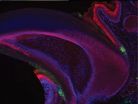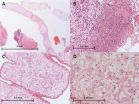Nail stem cells prove more versatile than press ons
2014-11-21
(Press-News.org) There are plenty of body parts that don't grow back when you lose them. Nails are an exception, and a new study published in the Proceedings of the National Academy of Sciences (PNAS) reveals some of the reasons why.
A team of USC Stem Cell researchers led by principal investigator Krzysztof Kobielak and co-first authors Yvonne Leung and Eve Kandyba has identified a new population of nail stem cells, which have the ability to either self-renew or undergo specialization or differentiation into multiple tissues.
To find these elusive stem cells, the team used a sophisticated system to attach fluorescent proteins and other visible "labels" to mouse nail cells. Many of these cells repeatedly divided, diluting the fluorescence and labels among their increasingly dim progeny. However, a few cells located in the soft tissue attached to the base of the nail retained strong fluorescence and labels because they either did not divide or divided slowly -- a known property of many stem cells.
The researchers then discovered that these slow-dividing stem cells have the flexibility to perform dual roles. Under normal circumstances, the stem cells contribute to the growth of both the nails and the adjacent skin. However, if the nail is injured or lost, a protein called "Bone Morphogenic Protein," or BMP, signals to the stem cells to shift their function exclusively to nail repair.
The researchers are now wondering whether or not the right signals or environmental cues could induce these nail stem cells to generate additional types of tissue -- potentially aiding in the repair of everything from nail and finger defects to severe skin injuries and amputations.
"That was very surprising discovery, since the dual characteristic of these nail stem cells to regenerate both the nail and skin under certain physiological conditions is quite unique and different from other skin stem cells, such as those of the hair follicle or sweat gland," said Kobielak.
INFORMATION:
Additional co-authors include USC researchers Yi-Bu Chen, Seth Ruffins and Cheng-Ming Chuong.
Funding came from the National Institute of Arthritis and Musculoskeletal and Skin Diseases (NIAMS) of the National Institutes of Health (NIH) Grants R03-AR061028, R01-AR061552, AR42177, AR 047364 and AR060306. Eve Kandyba is a Fellow of the California Institute for Regenerative Medicine (CIRM) Research Training Program II in Stem Cell Biology.
[Attachments] See images for this press release:

ELSE PRESS RELEASES FROM THIS DATE:
2014-11-21
Stress activates the immune system
The team focused mainly on a certain type of phagocytes, namely microglia. Under normal circumstances, they repair synapses between nerves cells in the brain and stimulate their growth. Once activated, however, microglia may damage nerve cells and trigger inflammation processes. The studies carried out in Bochum have shown that the more frequently microglia get triggered due to stress, the more they are inclined to remain in the destructive mode - a risk factor for mental diseases such as schizophrenia.
Susceptibility for stress effects ...
2014-11-21
A protein kinase or enzyme known as PKM2 has proven to control cell division, potentially providing a molecular basis for tumor diagnosis and treatment.
A study, led by Zhimin Lu, M.D., Ph.D., professor of neuro-oncology at The University of Texas MD Anderson Cancer Center, showcased the non-metabolic abilities of PKM2 (pyruvate kinase M2) in promoting tumor cell proliferation when cells produce more of the enzyme.
The study results were published in today's issue of Nature Communications.
Dr. Lu's group previously demonstrated that PKM2 controls gene expression ...
2014-11-21
Immunity is a thankless job. Though the army of cells known as the immune system continuously keeps us safe from a barrage of viruses, bacteria and even precancerous cells, we mainly notice it when something goes wrong: "Why did I get the flu this year even though I got vaccinated?" "Why does innocent pollen turn me into a red-eyed, sniffling mess?"
A new study from Johns Hopkins takes a big step toward answering this and other questions about immunity, shedding light on how the body recognizes enemies on the molecular level -- and how that process can go wrong. The results ...
2014-11-21
A genome of a rare species of tapeworm found living inside a patient's brain has been sequenced for the first time, in research published in the open access journal Genome Biology. The study provides insights into potential drug targets within the genome for future treatments.
Tapeworms are parasites that are most commonly found living in the gut, causing symptoms such as weakness, weight loss and abdominal pain. However, the larvae of some species of tapeworm are able to travel further afield to areas such as the eyes, the brain and spinal cord.
A 50-year-old man ...
2014-11-21
For the first time, the genome of a rarely seen tapeworm has been sequenced. The genetic information of this invasive parasite, which lived for four years in a UK resident's brain, offers new opportunities to diagnose and treat this invasive parasite.
The tapeworm, Spirometra erinaceieuropaei, has been reported only 300 times worldwide since 1953 and has never been seen before in the UK. The worm causes sparganosis: inflammation of the body's tissues in response to the parasite. When this occurs in the brain, it can cause seizures, memory loss and headaches. The worm's ...
2014-11-21
Current efforts to prevent violence against women and girls are inadequate, according to a new Series published in The Lancet. Estimates suggest that globally, 1 in 3 women has experienced either physical or sexual violence from their partner, and that 7% of women will experience sexual assault by a non-partner at some point in their lives.
Yet, despite increased global attention to violence perpetrated against women and girls, and recent advances in knowledge about how to tackle these abuses (Paper 1, Paper 3), levels of violence against women - including intimate ...
2014-11-21
WASHINGTON--Levels of violence against women and girls--such as female genital mutilation, trafficking, forced marriage and intimate partner violence--remain high across the world despite the global attention the issue has received. The focus needs to shift to preventing violence, rather than just dealing with the consequences, according to a new series on violence against women and girls published Friday in The Lancet.
Mary Ellsberg, director of the George Washington University's Global Women's Institute (GWI), co-authored one of the five papers published in the special ...
2014-11-21
Barcelona, Spain: In a second presentation looking at new ways of treating non-small cell lung cancer (NSCLC) that has both the EGFR and T790M mutations, researchers will tell the 26th EORTC-NCI-AACR [1] Symposium on Molecular Targets and Cancer Therapeutics in Barcelona, Spain, that an oral drug called ASP8273 has caused tumour shrinkage in patients in a phase I clinical trial in Japan.
Mutations of the epidermal growth factor (EGFR) occur in about 30-35% of Asian patients with NSCLC (and in 10-15% of Caucasian patients). EGFR inhibitors called tyrosine kinase inhibitors ...
2014-11-21
Highlights
Living organ donors who later need kidney transplants have much shorter waiting times, and they receive higher quality kidneys compared with similar people on the waiting list who were not organ donors.
In 2010, a total of 16,900 kidney transplants took place in the U.S. Of those, only 6,278 were from living donors.
Washington, DC (November 20, 2014) -- Prior organ donors who later need a kidney transplant experience brief waiting times and receive excellent quality kidneys, according to a study appearing in an upcoming issue of the Journal of the American ...
2014-11-21
Highlights
A 12-week course of aerobic exercise improved physical function and quality of life in patients with advanced chronic kidney disease.
The exercise program also decreased patients' pain.
More than 20 million people in the United States have chronic kidney disease.
Washington, DC (November 20, 2014) -- Simple yet structured exercise can significantly improve kidney disease patients' quality of life as well as decrease their pain, according to a study appearing in an upcoming issue of the Clinical Journal of the American Society of Nephrology (CJASN). The ...
LAST 30 PRESS RELEASES:
[Press-News.org] Nail stem cells prove more versatile than press ons



